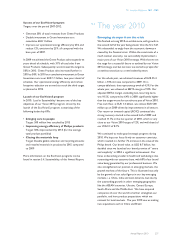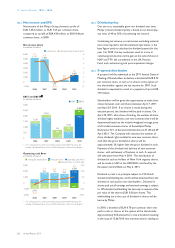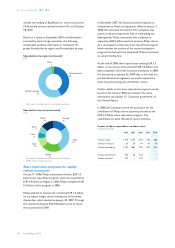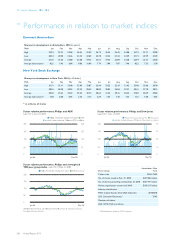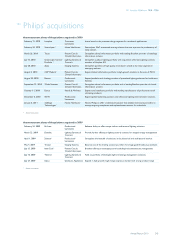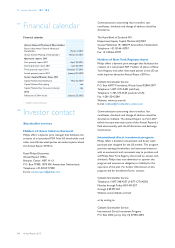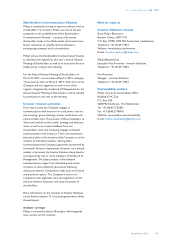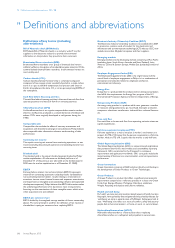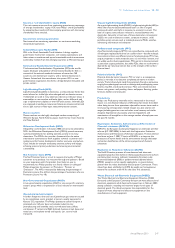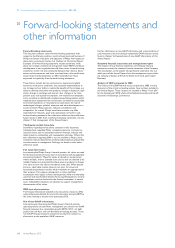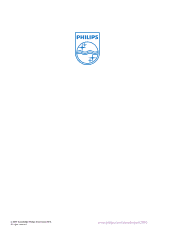Philips 2010 Annual Report Download - page 246
Download and view the complete annual report
Please find page 246 of the 2010 Philips annual report below. You can navigate through the pages in the report by either clicking on the pages listed below, or by using the keyword search tool below to find specific information within the annual report.19 Definitions and abbreviations 19 - 19
246 Annual Report 2010
19 Definitions and abbreviations
Definitions of key terms (including
abbreviations)
Bill of Materials check (BOMcheck)
BOMcheck (Bill of Materials check) is an industry wide IT tool for
suppliers to the electronic industry to provide environmental
information on the products they provide to their customers.
Brominated flame retardants (BFR)
Brominated flame retardants are a group of chemicals that have an
inhibitory effect on the ignition of combustible organic materials. Of the
commercialized chemical flame retardants, the brominated variety are
most widely used.
Carbon dioxide (CO2)
Carbon dioxide (chemical formula CO2) is a chemical compound
composed of two oxygen atoms covalently bonded to a single carbon
atom. It is a gas at standard temperature and pressure and exists in
Earth’s atmosphere in this state. CO2 is a trace gas comprising 0.039% of
the atmosphere.
Cash flow before financing activities
The cash flow before financing activities is the sum of net cash flow from
operating activities and net cash flow from investing activities.
Chlorofluorocarbon (CFC)
A chlorofluorocarbon is an organic compound that contains carbon,
chlorine, and fluorine, produced as a volatile derivative of methane and
ethane. CFCs were originally developed as refrigerants during the
1930s.
Comparable sales
Comparable sales exclude the effect of currency movements and
acquisitions and divestments (changes in consolidation). Philips believes
that comparable sales information enhances understanding of sales
performance.
Continuing net income
This equals recurring net income from continuing operations, or net
income excluding discontinued operations and excluding material non-
recurring items.
Dividend yield
The dividend yield is the annual dividend payment divided by Philips’
market capitalization. All references to dividend yield are as of
December 31 of the previous year (the yield on the dividend paid in
2010 uses the market capitalization as of December 31, 2009).
EBITA
Earnings before interest, tax and amortization (EBITA) represents
income from continuing operations excluding results attributable to
non-controlling interest holders, results relating to investments in
associates, income taxes, financial income and expenses, amortization
and impairment on intangible assets (excluding software and capitalized
development expenses). Philips believes that EBITA information makes
the underlying performance of its businesses more transparent by
factoring out the amortization of these intangible assets, which arises
when acquisitions are consolidated.
EBITA per common share
EBITA divided by the weighted average number of shares outstanding
(basic). The same principle is used for the definition of net income or
shareholders’ equity per common share, replacing EBITA.
Electronic Industry Citizenship Coalition (EICC)
The Electronic Industry Citizenship Coalition was established in 2004
to promote a common code of conduct for the electronics and
information and communications technology (ICT) industry. EICC now
includes more than 40 global companies and their suppliers.
Emerging markets
Emerging markets are the developing markets comprising of Asia Pacific
(excluding Japan, South Korea, Australia and New Zealand), Latin
America, Central & Eastern Europe, Middle East (excluding Israel) and
Africa.
Employee Engagement Index (EEI)
The Employee Engagement Index (EEI) is the single measure of the
overall level of employee engagement at Philips. It is a combination of
perceptions and attitudes related to employee satisfaction,
commitment and advocacy.
Energy Star
Energy Star is a product label for products with an energy consumption
that fulfills the requirements the Energy Star program of the U.S.
Environmental Protection Agency and the U.S. Department of Energy.
Energy-using Products (EuP)
An energy-using product is a product which uses, generates, transfers
or measures energy (electricity, gas, fossil fuel). Examples are boilers,
computers, televisions, transformers, industrial fans, industrial furnaces
etc.
Free cash flow
Free cash flow is the net cash flow from operating activities minus net
capital expenditures.
Full-time equivalent employee (FTE)
Full-time equivalent is a way to measure a worker’s involvement in a
project. An FTE of 1.0 means that the person is equivalent to a full-time
worker, while an FTE of 0.5 signals that the worker is only half-time.
Global Reporting Initiative (GRI)
The Global Reporting Initiative (GRI) is a network-based organization
that pioneered the world’s most widely used sustainability reporting
framework. GRI is committed to the framework’s continuous
improvement and application worldwide. GRI’s core goals include the
mainstreaming of disclosure on environmental, social and governance
performance.
Green Innovations
Green Innovations comprise all R&D activities directly contributing to
the development of Green Products or Green Technologies.
Green Products
A Green Product is a product that offers a significant environmental
improvement compared to a reference product in at least one Green
Focal Area: Energy efficiency, Packaging, Hazardous substances,
Weight, Recycling and disposal and Lifetime reliability.
Health and well-being
By ‘health’ we mean not only medical-related aspects of health, but also
keeping fit, having a healthy diet and generally living a healthy lifestyle. By
‘well-being’ we mean a general sense of fulfillment, feeling good and at
ease. ‘Well-being’ also refers to a sense of comfort, safety and security
people feel in their environment - at home, at work, or out and about.
Hydrochlorofluorocarbon (HCFC)
Hydrochlorofluorocarbon is a fluorocarbon that is replacing
chlorofluorocarbon as a refrigerant and propellant in aerosol cans.



